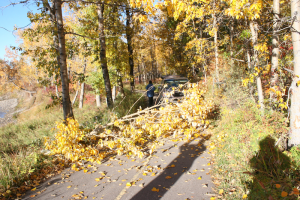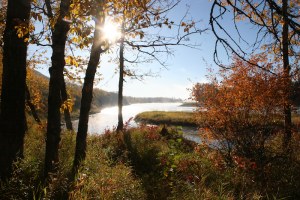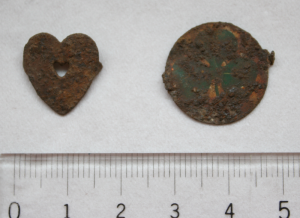Last month, I recounted my recent experience doing public archaeology at Glenbow Ranch Provincial Park. While I dispelled popular misconceptions about archaeology, there is more to tell about what we have actually discovered from our excavations at the Glenbow Workers’ Quarters.

Halted by a beaver’s debris

Morning mist on the Bow River
Most of the time we were working hard at our excavation, though, as we continued to expose the foundation of an historic residence and to piece together clues about the building’s construction and demolition. With one long wall and one short wall uncovered, we extrapolated the dimensions of the structure as roughly 5×7 meters. In several places there were large concentrations of ash and charcoal below the foundation stones. This may indicate attempts to thaw and level frozen ground. The foundation, made of river-worn cobbles, had a wooden sill-plate anchored above it, upon which wooden walls were raised. At the end of the building’s life, a fire occurred, depositing a thin black layer of soot directly atop the cobbles. All of this was buried over time, as dust blew in, gophers moved dirt around, and vegetation grew and then decayed. In one area, cobbles peaking through the grasses signaled the location for us to investigate, when we came along a hundred years after the building’s demise.
Volunteers dug in one square meter units, laid out in a grid. They mainly used trowels (masons’ pointing trowels are the standard) to scrape the soil into dustpans. Some people used other small hand tools to scratch the dirt from between the cobbles or away from artifacts. All loose earth was swept up and into buckets, which were then emptied through screens to catch all the small artifacts. The location of everything that was recovered was noted and finds were placed in labeled bags. These worn and decayed items may look like mere garbage to some people, but to us they are little treasures that hint at what happened here so long ago.
Based on old family photos and stories, we believe this building to be the two-room shack of Robert Dickson, the quarry manager. He lived there with his wife, Annabelle, and their three little girls (Ellen, Bella, and Sarah May) from 1909 to 1912. I could imagine some of the artifacts we have found actually being used by these individuals. For example, Mr. Dickson smoked a pipe, which his wife despised. She kept washing his pipes and Robert would have to start seasoning his pipe all over again. Perhaps Annabelle is responsible for the broken pipe stem and pipe bowl fragments we have found! There is even more evidence of the importance of tobacco here, since we have found several forms of tobacco tags, little advertising tokens included in the packaging of pipe and chewing tobacco. The tiny tin heart I described in last month’s article, shown on the left in the image below, was one of these from the W.C. MacDonald tobacco company and would have originally been covered in red enamel with the company name in black. The dates of production (1870 – 1922) fit nicely with the age of our site. The tag on the right, has a green, three-leaf shamrock with white veins on a white background. It has not been identified yet; if you have any ideas which company produced this, please leave a comment below.

Tobacco tags
Artifacts which support a domestic use of this building include several fragments of ceramics with various designs. Some are plain white, but others are decorated with bands of gold or with green transferware flowers. We also found one small piece of blue and white ceramic – an indigo-coloured rose on a white background. These pretty shards of teacups and saucers are a welcome relief from the rusty hue of the majority of the artifacts we recover. The most common items are nails of assorted sizes.
There are a few intriguing tarnished items, though. I was quite excited to find a modest piece of bent wire when I realized its kinks were there because it was a hairpin. I finally had direct evidence of the presence of a woman! Hello Annabelle! True, we did have a sewing pin, but men also had to have basic sewing skills, so although likely a female’s item, it could have belonged to a man. The most impressive man’s artifact found this year was a small chisel: whole, used, and a miniature of a punch (also called a point) we found two years ago. It was probably part of the same toolkit. How these precious tools of the stone mason’s trade came to be lost and forgotten is a mystery.
Through our 18 days of excavations at the Glenbow Workers’ Quarters this year, we have fully exposed the foundations of two walls of what is thought to be Robert Dickson’s home. In the process of uncovering the linear arrangement of cobbles, we discovered many artifacts. These ghostly remains of past events and long dead people have traveled through time, and although weathered, they hint at what life was like here a century ago.
It’s been another great field season at Glenbow Ranch and our thanks to all who came out and helped on this exciting project!
This article was originally printed in the Bergen News and is being reprinted with permission.